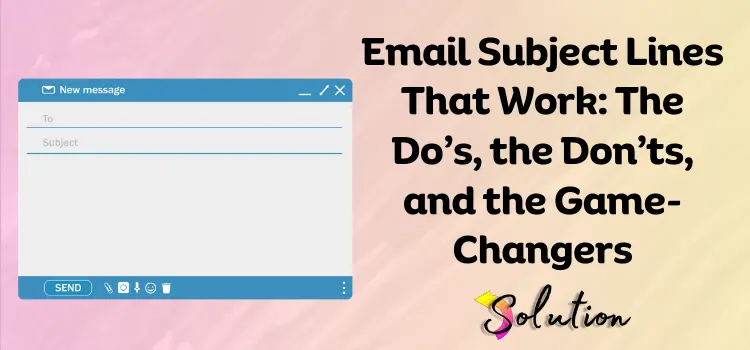
Would you ever consider wearing night clothes while going to a business meeting? Absolutely not.
Then why send an email with a sloppy subject line?
Just like your visual appearance matters a lot in a face-to-face meeting, the subject line of your email is the first impression you make in your digital world. It doesn’t matter how great or important your email content is; no one is going to take you seriously if the subject line is unprofessional or unclear.
Understand this: Your email subject line is the handshake of your message, and no one likes a weak handshake. First impressions matter a lot, and that may be one of the reasons why your emails may go unopened.
If your email subject line is not attention-grabbing, captivating, or relevant to the recipient, then it may get lost in a sea of other unwanted emails in the recipient’s inbox. It’s painful when you have spent hours crafting the perfect mail, but there are no responses or engagement.
Let’s be honest—your email subject line is like your dating profile’s bio. If it’s not interesting or appealing, no one will bother to click on it. The consequence of this failure is missed opportunities for communication, networking, and potential business growth. Therefore, just like you spend time crafting the email, it’s highly important as well to put effort into subject lines that entice recipients to open and engage with your emails.
In this guide, we will briefly walk you through the essential do’s and don’ts for crafting a perfect subject line that should make a good first impression. By following these tips, you can increase your email open rates and ultimately improve your chances of success in your professional endeavors.
Don’ts: Common Email Subject Line Mistakes to Avoid
1. Don’t Use the Caps Key—No One Likes Being Yelled At
With this, we mean, “LAST CHANCE TO GRAB THIS AMAZING DEAL.”
Read it again. Doesn’t it sound like you are yelling at your target audience?
Caps lock is not your friend, nor is the mail’s receptor. Subject lines written in all caps can come across as aggressive and unprofessional. It may potentially turn off recipients before they even open your email.
It even triggers the spam detection algorithm to give your email a big red flag and shows it in the spam section. In summary, using all-caps letters lowers the likelihood of spam.
2. Don’t Include Spammy Words
A single spammy word in your email subject line can flow water on all your email marketing efforts.
Words like “guarantee,” “free,” “urgent,” or “limited-time offer” are often associated with spam. These are the red flags that you have to avoid any cost. Nowadays, spam filters are smarter than ever. They have been designed to identify these types of spammy words and automatically move them to the spam folder.
Here, the key to success is maintaining a natural and conversational tone and avoiding over-promising results. By including genuine and helpful information, you can boost engagement and trust with your subscribers.
3. Don’t Fall in Trap for Salesy Words
Email marketing is all about building healthy relationships with your target audience, not just getting another single order or pushing sales.
Today’s customers are very smart, and they can feel a sense of danger or manipulation when bombarded with sales language. Overly aggressive, sales-driven words like “Hurry,” “Act Now,” or “Best Deal Ever” can make recipients feel like they are being pressured into making a purchase, which can make them feel better about unsubscribing from your emails.
These words make your email sound more like a pushy salesperson and less like a trusted source of valuable information. So, to improve your email deliverability and engagement, it is important to maintain a perfect strike of balance between promoting your product and providing valuable content.
4. Don’t Focus on Clickbait—Instead Build Trust
While everyone wants to engage with their target audience by enticing subject lines and creating hooks, having clickbait in your email subject line is something that can quickly turn off subscribers.
Clickbaits may work for social media posts, but when it comes to email marketing, it’s one of the worst dishes that is topped with disappointment and frustration.
For instance, subject lines like “You Won’t Believe What’s Inside” or “Shocking News Inside” only play with the recipient’s mindset to open the email and find a generic marketing pitch. These types of clickbaits only create frustration and increase unsubscribe rates.
Instead of using false or irrelevant clickbaits, try using deceptive curiosity hooks, which focus on clear and honest subject lines. These must reflect the email’s content.
For example, instead of saying “Shocking News About Our New Product Launch,” try “Exciting Updates on Our Latest Product Launch.”
Through this way, you can still create curiosity and interest without misleading your audience.
5. Don’t Forget Clarity—Confusing Subject Lines Get Ignored
Content is paramount when it comes to email subject lines. A confusing subject line can provide a quick ticket to your email in the trash folder.
If the mail recipient is unable to understand what the email is all about, they are less likely to open it.
So, the solution is to be direct and to the point. Instead of saying, “Don’t Miss Out on This,” just say “Last Chance: 20% Off on Your Next Order.” This tells the reader what to expect—an offer and an urgency factor.
Clarity builds trust and ensures your emails are not just opened, but also read and acted upon. So, keep your subject lines clear, concise, and informative.
Do’s: Best Practices for Effective Email Subject Lines
1. Add Personalization—By Speaking Directly To Your Audience
In an online world flooded with generic emails, personalization is your secret weapon to stand out. It’s not just about adding “Hi” or a name—it’s about showing your audience you know them.
For instance, instead of saying, “Big Sale! Flat 20% Off Everything!” you can say, “[First Name], Your Favorite Shoes Are Now 20% Off.”
This instantly gives the recipient a reason to open the email because it feels tailored to their interests and needs. Personalization will show you’re not just selling something—you’re offering value that resonates. So, speak directly to your audience’s needs and interests.
2. Do Create Urgency—but Avoid Overdoing
A little urgency can work like black magic in email marketing. But overdoing it makes it feel like a cheap sales tactic.
People are more likely to take action when they fear missing something. But if every email of yours starts sounding screams “LAST CHANCE” or “HURRY NOW,” then your audience will slowly start to disbelieve you.
So, instead of overwhelming your recipient with high-pressure language, try creating a subtle and soft urgency in a time-sensitive and natural approach. Urgency should be relevant and genuine. If it’s overdone, it loses its power. When done right, it sparks immediate action without making the recipient feel manipulated.
3. Keep it Short & Sweet—Avoid Wordy Subject Lines
Think of your subject line as a teaser trailer for a movie. It should be intriguing and short and leave the recipient wanting more.
The ideal subject line should be concise, direct, and impactful. Instead of writing “We Are Offering an Exclusive Discount on Our Bestselling Items for This Weekend Only,” simplify it to “Exclusive Weekend Deal—30% Off!”. It delivers the same message without unnecessary clutter.
Shorter subject lines are easy to read, remember, and act on. Aim for 6-9 words and focus on highlighting the most important information. Avoid using filler words or phrases.
4. Test & Analyze—Optimize for Maximum Open Rates
Crafting the perfect subject line is not done by art, luck, or guesswork. It’s a science that requires testing and analyzing different variations to see what resonates best with your target audience.
It may help you in understanding what works best and what doesn’t. A/B testing, also known as split testing, is one of the most effective ways to see what resonates perfectly with your target audience. Try testing different elements like tone, length, urgency, or personalization.
Once you have collected the valuable data, track open rates and engagement rates and see what works best. The more you test, the better you understand your target audience, and the more effective your emails will become.
5. Do Be Authentic & Be Honest
If you are offering something through your email subject line, then you should make sure that the email content delivers on that promise.
If you’re tricking someone to open your email, then they might open it once or twice. But over a period of time, they will stop opening your email. This may not only decrease your open rates but also damage your credibility with your audience.
Remember, honesty is the key to building long-lasting trust and relationships with your subscribers. So, be transparent and deliver real value and honest messaging. Strong and authentic relationships lead to better open rates, more conversions, and long-term success. So, always focus on keeping the email subject line real.
Your Way to Crafting a Perfect Email Subject Line
So, the next time you’re crafting an email subject line, consider it like the opening scene of a blockbuster movie. If it’s compelling, your audience will stick around the entire show. An email subject line is the first impression and the attention grabber of your email. If it’s clear and relevant, the recipient will surely open your email and read its content till the end.
Whereas, if it’s misleading or confusing, they’ll walk away—just like they will do in the middle of a boring movie. Therefore, next time, before you hit the send button, ask yourself: Is the subject line the email’s blockbuster opening scene? This is because Hollywood and Inbox share a common characteristic: only the most compelling stories capture the audience’s attention.


